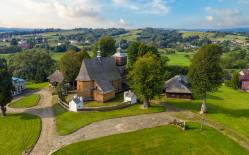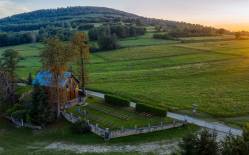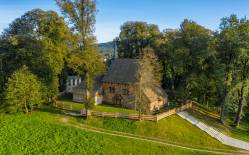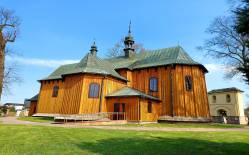This is one of the oldest and largest wooden Gothic churches in Europe. Dendrochronological testing showed that it was built in the 1450 or 1460s. Gothic wall paintings were discovered here in 1955, attracting scholars from all over Poland.
The church comprises a rectangular chancel, enclosed from the east within semi-hexagonal walls, as well as a sacristy on the northern side and a wider nave with a square floor plan. On the northern side of the nave there is a rectangular chapel of Our Lady of Sorrows from the 18th century, as well as a jewel box located between the chapel and the sacristy. The body of the church consists of three parts, including the chancel and the nave which are of the same height and are covered with a gable roof; it also comprises the tower. On the ridge of the roof there is an octagonal bell-turret from the 1600s. The side sections of the nave, above the casings, are covered with mono-pitched roofs. The log structure has stone foundations. It retains the original truss-log-bracket system of the upper covering of the building. The king post truss is reinforced alongside, and its structural elements carry medieval carpenters’ assembly markings. In the southern wall of the nave there is an entrance opening with ogival arch, and with doors featuring decorative Gothic fittings. Inside the church is covered with a flat ceiling, with casings supported on pillars in the nave, and with a cove in the chancel. The chancel entry is rectangular in shape. The oldest wall paintings include the fragments of the consecration crosses from the 1400s. The walls in the nave and the chancel are decorated with Gothic-style figural and ornamental polychrome paintings from 1494. Originally, Gothic paintings were also on the ceiling of the church. The only remnants today are eleven ceiling planks with fragments of medieval paintings. In the chancel on the northern wall, we can see a series depicting the Passion of Jesus, and on the southern wall there are representations of the murder of St. Stanislaus, coronation of the Blessed Virgin Mary and image of Archangel Michael. In the nave there are scenes from the Book of Genesis and images of saints. On the ceiling in the chancel and partly on the walls of the nave there are also 19th century paintings making reference to the traditions of Baroque ornamentation. The chapel of Our Lady of Sorrows features wall paintings representing architectural rococo decorations. At present you can see here many of the old church furnishings, such as a late Gothic sculpture of the Holy Mother and Child, a 16th century stone baptismal font with a wooden Baroque cover, altar of Christ the Merciful from the 1600s, with a copy of a Gothic Pietà in the side chapel (the original from ca. 1400 is kept in the brick church nearby), as well as 18th century side altars, pulpit and pipe organ casing.
In the square next to the church there is also a small wooden granary.
In Haczów you should also see the old manorial park with an ancient ash tree (girth of 514 cm), a wooden hospital from the 1800s, and you must visit the workshop of Stanisław Wyżykowski, a remarkable musician who also makes historical instruments and promotes wheel fiddles.
Photo: Krystian Kłysewicz
Gallery
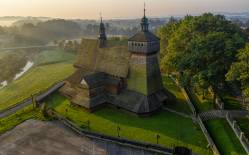
Recommended venues on the Trail



This website has been modernized with the financial support of the European Union under the Cross-Border Cooperation Programme Poland-Belarus-Ukraine 2014-2020. The responsibility for its content lies solely with the Podkarpackie Regional Tourism Board and cannot, in any case, be treated as a reflection of the position of the European Union, the Managing Authority, or the Joint Technical Secretariat of the Cross-Border Cooperation Programme Poland-Belarus-Ukraine 2014-2020.











